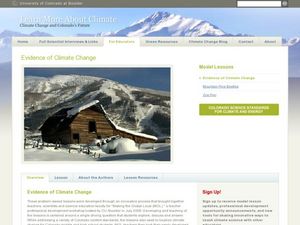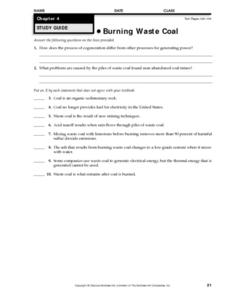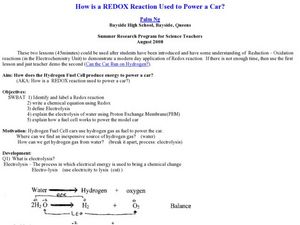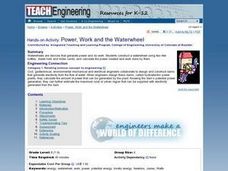Curated OER
Organic Chemistry Practice Exam 3
For this organic chemistry worksheet, students solve nine problems including predicting products of organic molecules, drawing mechanisms for reactions and drawing free energy diagrams.
Curated OER
Chem 152-Electrochemistry
In this electrochemistry activity, students solve a variety of problems including identifying parts of oxidation and reduction reactions, writing balanced equations for galvanic cells, determining free energy and equilibrium constants...
Curated OER
Electromagnetic Pick-up
Students investigate electromagnetic energy. In this magnetism instructional activity, students will create an electromagnet and test changes with increased energy. They will compete by building the strongest electromagnet.
Curated OER
The Environment and You
First graders examine the human environmental impact and discover ways to lessen effects. They create a pollution damage flow chart and write down what they think Mother Earth might say. They create inventions from recyclable materials.
Curated OER
Evidence of Climate Change
Sixth graders examine climate change in the state of Colorado. In this climate lesson, 6th graders watch 2 video clips regarding the topic and research the subtopics- snow pack, precipitation, temperature, forest fires, river flow,...
Curated OER
Solar Cell Simulation
Second graders describe how energy moves from the Sun to the photovoltaic cell to the wire and to the load. In this solar cell simulation lesson, 2nd graders demonstrate the movement of photons and electrons to emulate how solar energy...
Curated OER
Hazards: Third Grade Lesson Plans and Activities
Learners discover hazards related to volcanoes and predict the effects these hazards have on people and land. As blossoming geologists explore various volcanic eruptions, including the hazards associated with them, they...
National Park Service
The Water Cycle Game
Take young scientists on a trip through the water cycle with this interactive science activity. After setting up a series of ten stations representing the different places water can be found, children use the included printable dice...
CK-12 Foundation
CK-12 Earth Science Concepts for Middle School
Explore a variety of science concepts in an interactive textbook created for middle school scholars. A lengthy table of contents takes readers to pages comprised of a subject overview, outline, and summary. Follow links further to find...
Texas State Energy Conservation Office
Investigation: Concept Mapping Fuels
After reading an article, "Fuels for Everything," collaborative groups create a concept map poster of the transportation and non-transportation fuels. This makes a strong introduction to the different types of fuels used for transportion...
Virginia Middle School Engineering Education Initiative
Save the Penguins: An Introduction to Thermodynamics and Heat Transfer
Heat things up in your physical science class with this interactive lesson series on thermodynamics. Through a series of class demonstrations and experiments, young scientists learn how heat is transferred through conduction,...
Purdue University
Mammal Food Webs
You are what you eat—or at least a part of what you eat. Budding scientists examine owl pellets to develop their own food webs. They use tooth and skull identification techniques to classify what they find.
Alabama Wildlife Federation
Big Fish, Little Fish
Tag, you're eaten! A lesson on predator-prey relationships uses the game freeze tag as a model. Learners become either a predator or prey and play a game of tag as the prey tries to reach areas that house food and shelter. During the...
Curated OER
Circle of Life
Pupils consider why we eat and where our food obtains its energy. They illustrate food chains that might be found on an open field, dissect owl pellets, identify the remains of animals in the pellets, watch videos and participate in...
Curated OER
Food Chains and Food Webs
Students discuss the characteristics of producers, consumers and decomposers. Using a flow chart, they construct a food chain to visually show how organisms with different energy sources depend upon one another. Students explore a...
Curated OER
Food Web Follies
Seventh graders cut and paste animal pictures to create a food web and trace the path of energy. They write a paragraph explaining the importance of photosynthesis in all food webs.
Curated OER
Connect the Species
Fourth graders, in pairs, explore energy transfer and species interrelationships by viewing slides on a microscope. hey explore phytoplankton (producers) and zooplankton (consumers)
Curated OER
Understanding Interactions Among Local Species and the Local Environment
Students examine the differences between biotic and abiotic factors, explain the difference between habitat and niche and compare how organisms get their nutritional needs. In this local environment lesson students trace the path...
Curated OER
Thar She Blows!
Learners identify the advantages and disadvantages of wind farms and turbines. They examine how weather conditions can affect their effectiveness and how engineers are trying to solve the problem. They discover how engineers use this...
Curated OER
Burning Waste Coal
In this coal worksheet, high schoolers compare the process of cogeneration with other process for generating power. Students determine what happens to the waste coal. This worksheet has 2 short answer and 8 true and false questions.
Curated OER
How is a REDOX Reaction Used to Power a Car?
Students explore electrolysis and Redox reactions. In this exploratory lesson students demonstrate an example of electrolysis and how it brings on a chemical change.
Curated OER
The Physical Setting
Tenth graders examine chemical reactions. In this chemistry lesson students choose an investigation that they wish to perform based on their interest.
Curated OER
Physical Science Review 5th Grade
In this review of physical science instructional activity, students use recall to answer multiple choice questions about electricity and chemical changes. Students answer 25 questions.
Curated OER
Power, Work and the Waterwheel
Students use a two-liter bottle, dowel rod and index cards to design and construct a water wheel. They then calculate the power created and measure the work done by the water wheel in Watts and Joules.
Other popular searches
- Energy Flow
- Energy Flow in Ecosystems
- Ecosystem Energy Flow
- Energy Flow Energy Pyramid
- Energy Conversion Flow Chart
- Energy Flow Charts
- Energy Flow Diagram
- Ecology, Energy Flow
- Energy Flow Chart Diagrams
- Ecology Energy Flow
- Energy Flow in an Ecosystem
- Energy Flow in Ecology

























